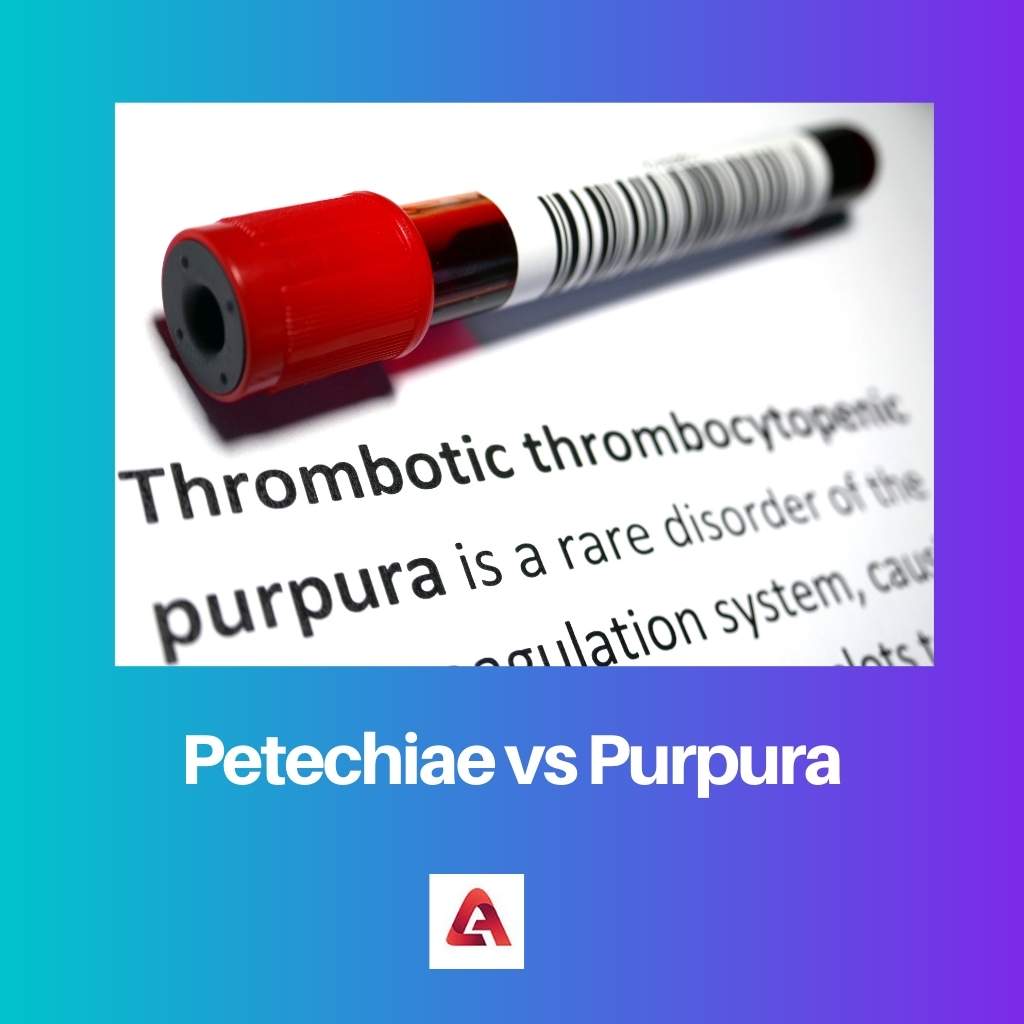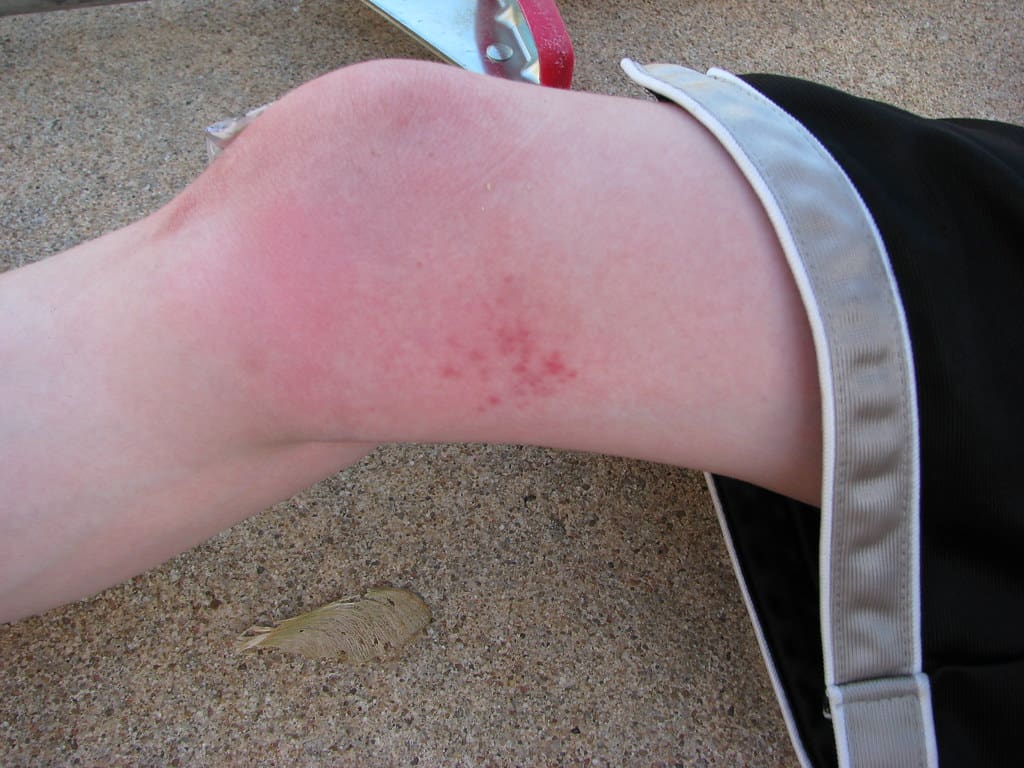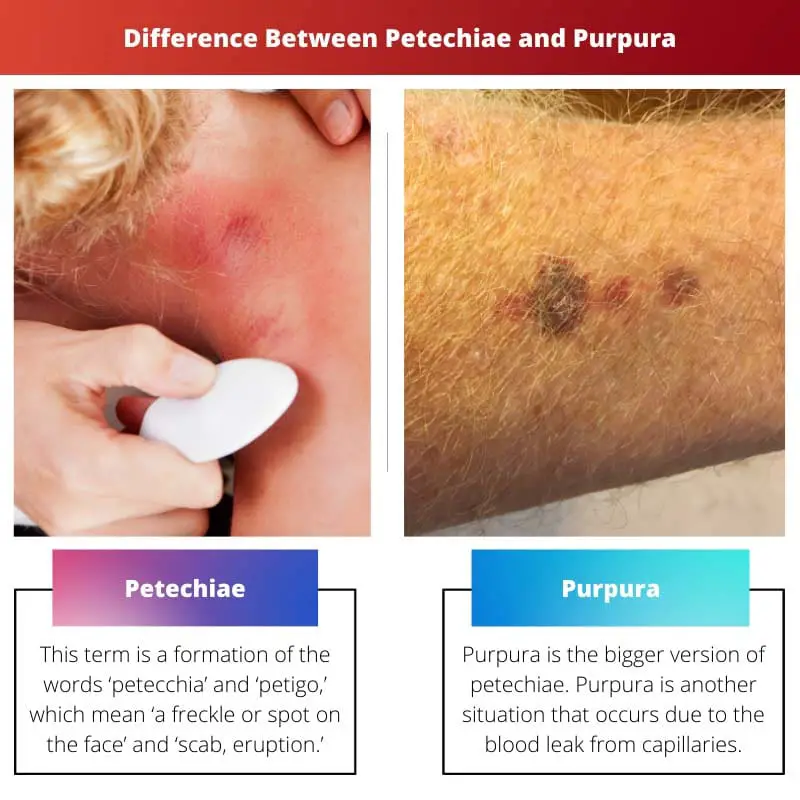Skin problems are something that almost every individual faces in one way or another. They can be caused due to various reasons, such as health conditions, stress, hormonal imbalances, and so on. However, there are some, if not diagnosed, that can lead to further damage, like Petechiae and Purpura.
Key Takeaways
- Petechiae and purpura are skin conditions characterized by small spots or bruises.
- Petechiae are smaller than purpura and do not cause pain.
- Purpura is larger than petechiae, can be painful, and is associated with underlying medical conditions.
Petechiae vs Purpura
Petechiae are small, pinpoint-sized red or purple spots on the skin. They are caused by bleeding from small blood vessels in the skin and may appear as a result of minor trauma or infection. Purpura is larger areas of purple or red discoloration on the skin, measuring 1cm or more in diameter. They are caused by bleeding from blood vessels in the skin.

Petechiae is a condition in which there is discoloration of the skin. In this situation, small patches of different colors occur. They are mainly red, pink or purple. These patches occur within the layer of the skin. Due to the breakage of the blood vessels present under the skin, which causes bleeding.
Purpura is another condition in which there is skin discoloration. It is similar to the situation of small patches of mainly red, pink, or purple colors. Also caused due to the breakage of the blood vessels present under the skin, which causes bleeding. However, they are bigger in size.
Comparison Table
| Parameters of Comparison | Petechiae | Purpura |
|---|---|---|
| Etymology | The term is derived from the modern Latin and Italian words ‘petecchia’ as well as the Latin word ‘petigo.’ | The term is derived from the Greek word ‘porphura,’ meaning ‘purple.’ |
| Appearance | These are different colored patches, mainly red, pink, or purple, below the skin, which are predominantly flat. | These are different colored patches, also mainly red, pink, or purple, within the skin which can be flat or raised. |
| Size | Their usual size is less than two millimeters. | Their usual size is more than two millimeters. |
| Cause | Due to the leaking of the capillaries caused by breakage under the skin. They may also be formed around purpura or among them. | They are caused by the breakage and leakage of blood capillaries under the skin. |
| Meaning | They are also known as smaller purpuras. | They are a symptom of a medical condition. |
What is Petechiae?
This term is a formation of the words ‘petecchia’ and ‘petigo,’ which mean ‘a freckle or spot on the face’ and ‘scab, eruption.’ They are also known as ‘Blood Spots.’
The reason behind this is also the same. Sometimes the small capillaries of blood present under the skin burst, and the blood in these capillaries leaks. The leakage of blood leads to the formation of patches under the skin.
These patches appear in different colors, mainly red, pink, or purple. Petechiae are one of the patches that occur due to this situation. The size of these patches, in this case, is smaller than two millimetres. Also, they are flat in general.
The leaked blood is then absorbed by the body. And in this process, the color of these patches also changes. The transition is as follows: pink-red-purple- brown/ orange/ blue/ green. The fading of these spots does not occur under pressure. They seem like some kind of a rash.
These can spread to the regions of the skin surrounding that area. They also occur in the case of Purpura, around them or among them. These can develop in the case of children, too, and are a symptom of a medical condition and can be treated in many ways. They are somewhat smaller versions of purpura.

What is Purpura?
Purpura is the bigger version of petechiae. Purpura is another situation that occurs due to the blood leak from capillaries. There are various reasons why the blood capillaries burst and cause leakage of blood.
These are also in red, pink, or purple colors. However, the size, in this case, is more than two millimetres and, in some cases, is slightly raised. They can also occur under mucous membranes.
Purpuras also seem like blood clusters and rashes. And also change color with the absorption of leaked blood by the body. The affected areas define the amount of leakage of underlying blood. Purpuras are larger than petechiae.
They are, however, not irritating or itchy. These, too, are a symptom of a medical condition that may be more severe. But in most cases, they are treated even with simple steps.
There are mainly 3 types of purpura and petechiae: Thrombocytopenic purpura and petechiae, Non-thrombocytopenic purpura and petechiae, and Purpura and petechiae from other clotting disorders.
There are different conditions that lead to the formation of purpura and petechiae: UV light damage, aging of the skin, collagen loss, various vitamin deficiencies, allergic reactions, medications, surgeries, skin damage, or blood vessel damage.
Main Differences Between Petechiae and Purpura
- The term petechiae are derived from the modern Latin and Italian words ‘petecchia’ and the Latin word ‘petigo’. The term purpura is derived from the Greek word ‘porphura,’ which means ‘purple’.
- Petechiae are those different colored patches, mainly red, pink, or purple, below the skin, which are predominantly flat. Purpura is the different colored patches, also mainly red, pink, or purple, within the skin, which can be flat or raised.
- The usual size is less than two millimetres in the case of petechiae. The usual size is more than two millimetres in the case of purpura.
- The leaking of the capillaries caused by breakage under the skin cause petechiae. However, it may also be formed around purpura or among them. Purpura is a result of the breakage and leakage of blood capillaries under the skin.
- Petechiae are also known as smaller purpuras. Purpura is a symptom of a medical condition.

- https://www.researchgate.net/profile/Marjolein-Wintzen/publication/8588806_Autoimmune_progesterone_dermatitis_presenting_with_purpura_and_petechiae/links/59e4541eaca2724cbfe76067/Autoimmune-progesterone-dermatitis-presenting-with-purpura-and-petechiae.pdf
- https://www.bmj.com/content/352/bmj.i1285.abstract

The thorough explanation of petechiae and purpura demonstrates the significance of knowledge in identifying and addressing skin conditions. This article presents vital information on dermatological health.
Indeed, the depth of insight offered here is commendable, as it serves to cultivate a well-informed readership and enhance awareness about skin-related medical issues.
The detailed explanation of petechiae and purpura helps to raise awareness about these skin conditions and encourages individuals to seek medical advice if they observe any concerning symptoms.
I agree. Improved understanding of petechiae and purpura can ultimately lead to early detection and prompt treatment, which is beneficial for overall health outcomes.
Absolutely, knowledge of these conditions can empower people to take charge of their health and make informed decisions. This article facilitates an important educational resource on the subject.
The detailed descriptions and the comparison chart effectively encapsulate the nuances between petechiae and purpura. This level of depth in the discussion sets a high standard for medical literature.
Absolutely, this article’s focus on providing comprehensive and well-structured information on petechiae and purpura is instrumental in fostering better awareness and understanding.
I completely agree. The multifaceted approach taken in this article is indicative of a rigorous analysis, contributing significantly to the understanding of these dermatological conditions.
The detailed descriptions of petechiae and purpura, including their etymology and the causes behind these skin conditions, offer valuable insights. It’s crucial to be informed about such medical issues.
Absolutely, the comprehensive nature of the information provided will enable readers to develop a deeper understanding of these skin conditions and recognize potential health concerns.
Indeed, this article’s focus on the origins, characteristics, and implications of petechiae and purpura contributes to a more enlightened discourse on dermatological health issues.
The comprehensive details on the causes and characteristics of petechiae and purpura are enlightening. This article provides valuable knowledge to promote better understanding of dermatological conditions.
Absolutely, the in-depth insights presented here can aid in early detection and management of such skin conditions, leading to improved health outcomes for individuals.
This article provides a thorough comparison between petechiae and purpura, as well as detailed explanations of their causes and appearance. It’s important to understand these skin conditions to detect any underlying health issues.
I completely agree. This information is valuable for everyone to know in order to recognize potential skin issues and seek appropriate medical attention.
Yes, the detailed description of the causes and visual appearance of petechiae and purpura is very helpful. It encourages vigilance and may prevent complications from arising.
The detailed descriptions and clinical insights are crucial in understanding petechiae and purpura. This article provides an exceptional resource for individuals seeking in-depth knowledge about dermatological conditions.
Absolutely, the depth and clarity of information presented here are commendable, contributing to an elevated understanding of dermatological ailments among the public.
Indeed, the comprehensive nature of this article encourages informed discussions and raises awareness about the potential implications of petechiae and purpura.
Understanding the etymology of the terms ‘petechiae’ and ‘purpura’ provides a fascinating insight into their historical origins. It’s great to see such comprehensive information in this article.
Absolutely, delving into the linguistic roots of these terms adds a unique dimension to the discussion of these skin conditions. It underscores the depth of knowledge required to fully comprehend medical concepts.
This article offers vital insights into petechiae and purpura, emphasizing the importance of recognizing the differences and understanding their implications. It’s a valuable contribution to medical knowledge.
Well said. The educational value of this article is substantial, given its capacity to equip readers with essential information to identify skin conditions and seek appropriate care.
Absolutely, the emphasis on promoting awareness and understanding of these dermatological conditions is commendable. It enhances the overall literacy on health-related topics.
The comparison table clearly outlines the distinguishing features between petechiae and purpura. It serves as an excellent reference for understanding the key differences in size, etymology, and appearance of these skin conditions.
I couldn’t agree more. The visual representation of their differences enhances our understanding, and the concise presentation of information is highly educational.
Definitely. Having a structured comparison table helps in clarifying any potential confusion between petechiae and purpura, allowing readers to grasp the details more effectively.